To protect the home from heat loss in the winter season, as well as improve the exterior ...
|
|
Bleing wide wallpapers is a complex, but fairly fast process. This material ... |
A cozy atmosphere is one of the main requirements for housing ... |
Installation of tissue stretch ceilings
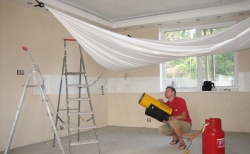
Stretch ceilings are a very spectacular and modern solution for the repair of premises for various purposes. To date, in the market of finishing materials, they occupy one of the leading positions due to a large set of positive qualities. There are two main types of suspended ceilings known to consumers: PVC film canvases and fabric stretch ceilings. The drapery of the ceiling with fabric looks very attractive, and most importantly, unique! And if you have prepared more than one fabric option, you can often change the interior of your room.
Content:
The story of a fabric ceiling
For a long time, PVC canvases appeared on the market. This material began to be actively used in the 60s of the twentieth century. Russian consumers learned about suspended ceilings in 1995-96. But the fabric canvases were recently invented - in 2000, you can see this by watching a video about the installation of a stretch fabric ceiling. And this was a revolutionary discovery in the world of repairs! Because the material was created more environmentally friendly than a plastic film. And, of course, more durable.
However, even from the ancient world, the first references to the use of fabric for the ceiling as a coating came to us. Stretched silk was blocked by the underground space in ancient Egypt, Rome and Greece. In this way, it turned out to hide the shortcomings that were on the main ceiling. Also, such canvases served to decorate the premises. But still, such designs had to be changed often, because over time the canvases accumulated dust, yellow and sagged.
Stories are known and other examples of the use of fabric for the ceiling. For example, in Armenia, the manufacture of tissue stretch ceilings is kept secret. The method that the old masters practiced was known: the canvases were impregnated with chalk solution, the fabric in raw form was fixed along the perimeter of the room, then the cotton was pulled when the chalk dries. It turned out a smooth and perfectly flat surface. But the same shortcomings as the canvases that were made in the ancient world are inherent in such a fabric stretch ceiling: dust and fragility accumulation.
In the middle of the 20th century, the active development of the chemical industry has been observed. And there is nothing to be surprised that with the invention of the PVC film, it began to be used for the ceiling as a finishing material. In the late 90s, a completely new mount was invented, and it did not fit for the material. The study took three years. And the result was the manufacture of polyeast fabric of a rather complex weaving, which was produced on weaving machines, and then impregnated with polyurethane.
Characteristics of fabric canvases
Experts note several rather important qualities that differ in tissue ceilings:
- Strength. The polyetrous canvas compared to the film is much stronger - about 10-20 times. This allows random damage not to be afraid, for example, children's darts or traffic jams from champagne. It is not so easy to open such a fabric with an acute angle or scratch it. And stretch ceilings from the film still require a careful attitude to themselves.
- Air permeability. In such a fabric canvas for suspended ceilings, micropores are the basis, with the help of their ceiling breathes, that is, it does not interfere with the circulation of air flows in the room and creates very good acoustics.
- Seamlessness. Fabric ceilings are produced in rolls, the width of which is up to 5.1 meters, unlike the PVC film, the width of which is not more than 3.5 meters. This allows you to block fairly wide rooms without welds. Experts say that the weakest place is the welded seam of the film ceiling. The ceiling can break here.
- Installation technology. Installation of a fabric canvas is safer. No need to heat the room with the help of heat guns, which is necessary in the case of installation of the PVC film. There is no need to take out objects from the room sensitive to high temperatures, so the installation time decreases. Stretch fabric ceilings do not require the exact size of the room, due to inaccurate measurement, the breakdown of the installation time is not possible. The canvases are simply attached to a special baguette, and then stretched. Thanks to this quality, the installers and independent masters love the seamless ceiling.
- Environmental friendliness. You can install stretch ceilings on a fabric base in any room (in the children's room too), since they are not smell. Even quite expensive film ceilings after installation for several days have a specific smell. Polyesh tissue, in addition, has antistatic quality and guarantees the lack of condensation and dust.
- Decorative function. At your request, stretch fabric ceilings can turn into a real masterpiece. The canvas can be repainted simply in a different color using acrylic paints or decorated with manual painting. For such materials, photo printing is also available. Fabric stretch ceilings are suitable for multi -level and curved structures.
- Resistance to temperature fluctuations. Fabric stretch ceilings are not afraid of frost or heat. Therefore, they are set in seasonal, under construction and not heated rooms (underground parking, loggias, cottages, garages). At a temperature of less than 10 degrees, the PVC film can crack and becomes fragile.
The main drawback of such paintings is the price of tissue stretch ceilings, it is much larger than the cost of PVC film. The square meter of the canvas of European manufacturers costs about 600 rubles. The price is affected by the fact that such ceilings are produced exclusively abroad, as well as the quality of the material. Some of the most popular manufacturing companies - Cercor (Germany), Cerutti (Italy), Clipso (Switzerland). Russian manufacturers have so far mastered only the methodology for the manufacture of ceilings from the PVC film.
In addition to the high cost of tissue stretch ceilings, the canvas is also inherent in other disadvantages:
- It is not too convenient that only after installation can they be painted or painted with acrylic paints.
- Polyes fabric ceilings in case of flooding cannot completely retain moisture.
- It is not possible to re -reconnect such a ceiling.
Fabric ceilings are suitable for finishing in various rooms, for example, in the nursery, because these ceilings are not afraid of any external influences - in the form of a ball that came into the ceiling (but only if it is not scissors or knife), or in the kitchen, since for It is easy to care for the fabric.
DIY tissue ceiling
Depending on the size of the ceiling in the room, it will be required to decorate the surface of 2-3 meters of quality fabric, for example, German curtain, as shown in the video about tissue stretch ceilings.

Preparation of the ceiling for finishing
In the process of building a fabric ceiling and gluing the fabric to the surface, you need to adhere to the following steps: to align and emphasize the surface to obtain the perfect smoothness of the surface, tightly pull on, as if the canvas on the subframe, and at the same time open the existing irregularities in the ceiling.
To perform these actions, it is required at the beginning to clean the ceiling from any contaminants, fill all the cracks and cracks with putty and dry, as well as remove roughness by grinding with sandpaper. There should be no spots on the ceiling that are able to appear during the fabric, you need to seal them with a thin foil made of aluminum, or apply a layer of nitroemali.
If there is an oil paint on the surface, then it should be first washed with a solution of water in which soda is added, and then dry well. After that, it is recommended to clean everything with sandpaper.
The first method of installation of the ceiling
For installation of a fabric stretch ceiling, it is necessary to prepare a ceiling profile, aluminum is considered the best, which is more reliable and durable. In the middle in the profile, the fabric is fixed, leaving a supply equal to 5-6 centimeters. We pull the canvas with a little step, while trying to align it as much as possible. You should start from the middle of the room to its corners, moving in both directions.
We fix the canvas in the direction of movement in the baguette, and at the end in the corners of the profile we fix it. If there are folds on the fabric, then they can be removed using a building hair dryer. We warm these places with smooth circular motions, while hold the hair dryer at a distance of 20 centimeters from the canvas and set the temperature of 180 degrees. Next, as the installation was finished, the protruding pieces of the clus on the profile is removed, after which you need to install decorative plugs.
The second method of installation of the ceiling
There is another rather interesting way to independently install a fabric stretch ceiling. Harp wooden bars with a cross section of each angle 2 to 3, any construction workshop can quickly make them. It is better to order the length of the beam of 50 centimeters more measurements, due to the fact that the angles are subsequently subject to cutting. To obtain a yellow shade and for processing the bars, the penatex should be used.
You will also need eight metal corners and a ribbon-forming ribbon, which can be purchased in sewing stores. Next, make a frame that you will hang on the ceiling surface. With a special stapler, we attach the rigid side of the tape to the protruding part of the beam, before that gluing on liquid nails.
The finished frame is under the lamp, if suddenly it is not transparent, then you will need a more powerful lamp. If you have chosen a transparent or thin fabric, then ordinary lighting is suitable. Now you have to bring the resulting design to the ceiling. The solution is unusual if you take the chains and hang the frame to the ceiling on them, and do the fastening to the ceiling with the help of a pipes holder.
After screwing the hooks into the frame and the installation of a fabric stretch ceiling with your own hands, it remains only to admire its work. This design is practical and very reliable. If you get distortions along the walls during the installation of the frame on the chains, an important point will be adjusting the desired suspension to the chain link in order to reach the parallel in all corners.
Great convenience lies in the ability to easily remove the structure from the ceiling, removing from a pair of hooks on one side of the chain. Having lowered the frame from the ceiling, you can quickly and easily remove the fabric from it to replace it with another or for washing. To do this, you just need to remove the fabric from Velcro.


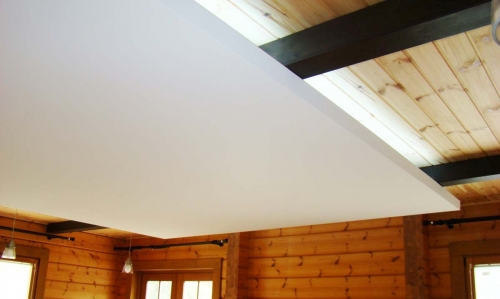
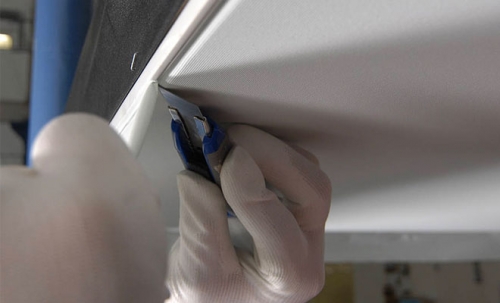
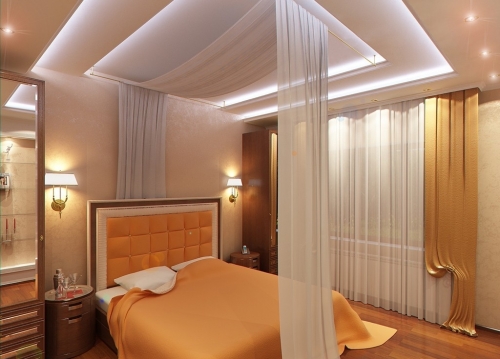
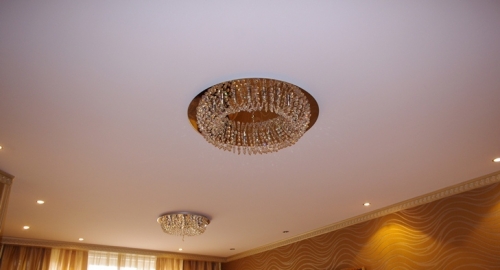
Asta M company reveals
Asta M company reveals the secret to the installation of stretch ceilings in a room with a dressing room. Also, from this video, you will learn how to install a fabric stretch ceiling using a graduate/wedge system. Asta M company reveals the secret to the installation of stretch ceilings in a room with a dressing room. Also, from this video, you will learn how to install a fabric stretch ceiling using a graduate/wedge system. https://www.youtube.com/watch?v\u003dHG9XLALPNF8
Asta M company shot video
ASTO M company shot video how to install a stretch ceiling using the "clothespin" profile
Link to the video https://youtu.be/naep5hv4e_u